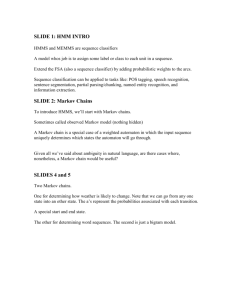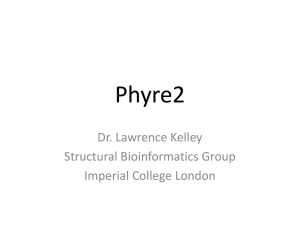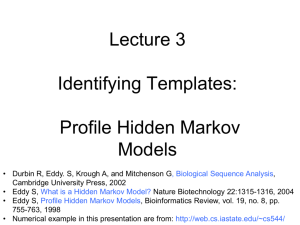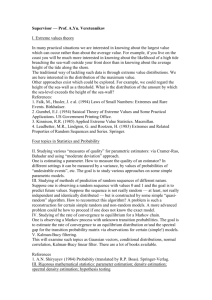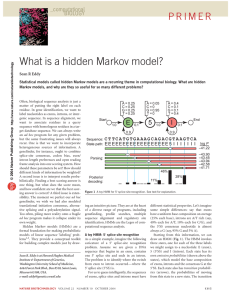Accent Identification for Saudi Speakers
advertisement
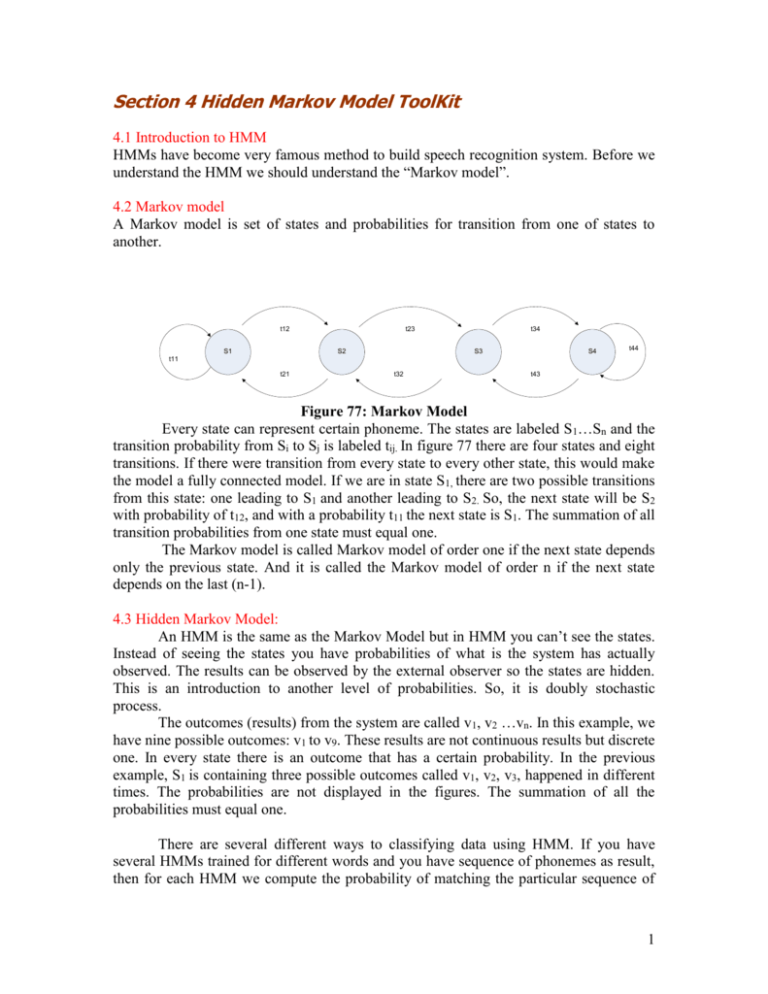
Section 4 Hidden Markov Model ToolKit 4.1 Introduction to HMM HMMs have become very famous method to build speech recognition system. Before we understand the HMM we should understand the “Markov model”. 4.2 Markov model A Markov model is set of states and probabilities for transition from one of states to another. t12 S1 t23 S2 t34 S3 S4 t44 t11 t21 t32 t43 Figure 77: Markov Model Every state can represent certain phoneme. The states are labeled S 1…Sn and the transition probability from Si to Sj is labeled tij. In figure 77 there are four states and eight transitions. If there were transition from every state to every other state, this would make the model a fully connected model. If we are in state S1, there are two possible transitions from this state: one leading to S1 and another leading to S2. So, the next state will be S2 with probability of t12, and with a probability t11 the next state is S1. The summation of all transition probabilities from one state must equal one. The Markov model is called Markov model of order one if the next state depends only the previous state. And it is called the Markov model of order n if the next state depends on the last (n-1). 4.3 Hidden Markov Model: An HMM is the same as the Markov Model but in HMM you can’t see the states. Instead of seeing the states you have probabilities of what is the system has actually observed. The results can be observed by the external observer so the states are hidden. This is an introduction to another level of probabilities. So, it is doubly stochastic process. The outcomes (results) from the system are called v1, v2 …vn. In this example, we have nine possible outcomes: v1 to v9. These results are not continuous results but discrete one. In every state there is an outcome that has a certain probability. In the previous example, S1 is containing three possible outcomes called v1, v2, v3, happened in different times. The probabilities are not displayed in the figures. The summation of all the probabilities must equal one. There are several different ways to classifying data using HMM. If you have several HMMs trained for different words and you have sequence of phonemes as result, then for each HMM we compute the probability of matching the particular sequence of 1 phonemes (output) with the current HMM. The HMM that has the highest probability is considered as the most likely word. To do this task you should train the HMMs for every word. 4.4 Introduction to HTK The Hidden Markov Model Toolkit (HTK) is used to build the Hidden Markov Models (HMM). In automatic speech recognition (ASR) the inputs are represented as signal appropriate to processing and placed into recognition process. The output is transcription of utterance. The speech recognition is hard job and the modern systems in speech recognition are very complex. Components of ASR: In the first step, we extract features (as parameters) from the signal that have the maximum number of relevant information from the classification. There are two characteristics to features: (1) Features are robust to acoustic variation (2) Features are sensitive to linguistic contents. # We need to extract features that can be used to distinguish between the different utterances. Also, we want to discard the noise and factors that are irrelevant (for example: the fundamental frequency of the speech signal #). Usually the numbers of features that are extracted are lower than the signal numbers that means the amount of data will decrease. There are appropriate features for each classification technique. See figure (1) In figure (2), we can see how features can be estimated. The features that are extracted are parameterized based on a frequency-domain. Spectral analysis is performed on the speech sample, e.g. every 10ms in a window of size 32ms length. People consider that the speech signal is static in this time scale. This is not always true, but it is a reasonable approximation. We extract the features in each frame then we give it to the next stage (classification). 2 The acoustic models are referenced patterns that are matched to the featured vector in the classification model. The reference patterns are HMMs trained for either complete words or sub-word (phones) as linguistic units. HMMs are flexible with duration variation. This characteristic is important because the duration of phones may differ between the reference speech signal (train speech set) and speech signal to be recognized (test speech set). The different phones do not take the same time. For example, the vowels consume time differ according to speaking rate but the consonants (like: ”d” ,”t” ,”g” ,”k” ,”b” and “p”) usually do not change their length of time much. The pronunciation dictionary determine whereas the word to be recognized is valid or not. The pronunciation dictionary can do this task using all the valid combination of phones. The pronunciation dictionary can also contain different variants of the same word. (See table 1). 3 The language model contains syntactic information (grammar of the language). Its goal is to predict the probability of occur of specific words one after another in a specific language. Sub Word Modeling:When the language has a large vocabulary ASR system, we can use HMMs to represent sub units of words (for example: phones). For example, English has around 40 models. The phone set is represented using the dictionary. We can build the word model using sub word models. In the same phone, if the neighboring phones are different then the phone itself is differ (context of phone is affect). Context dependent phone model are most widely used. There are several types of models: (1) Mono-phone: consider current phone. (2) Bi-phone models: consider either the left or right phone. (3) Tri-phone models: consider both left and right phones. (See figure 3). 4 In speech recognition it is important to balance all of steps: acoustic model, pronunciation dictionary and language model. 2- Hidden Markov Model Toolkit (HTK): HTK is ready tool to build HMMs. HTK is used for speech recognition but we can use it to another purpose. Using HTK to Recognize Accent: We labeled the phonemes as accents e.g. the accents are (w, e). Then in the dictionary file we label them as the meaning of the accent e.g. the meaning of the accents are (WESTERN w, EASTERN e). Then in the grammar we put what is the recognized accent e.g. the recognized accent is: (WESTERN | EASTERN). Then for each wave file we label them as the corresponding accent. 5


